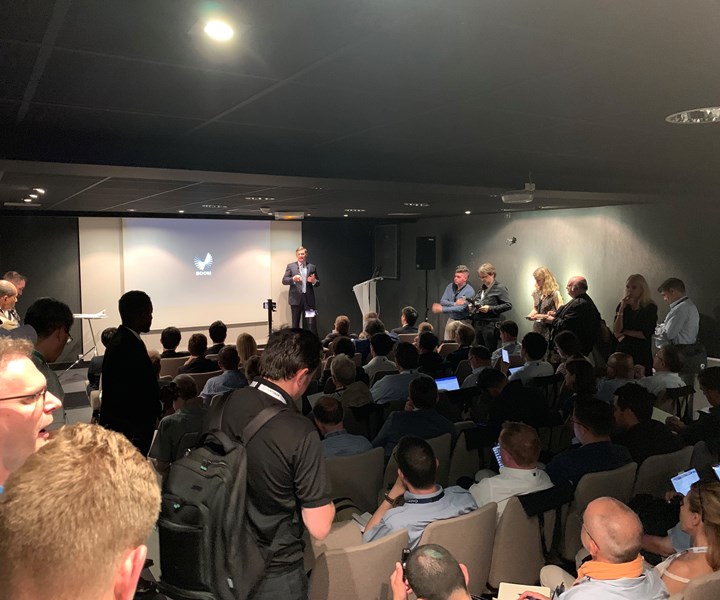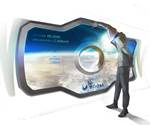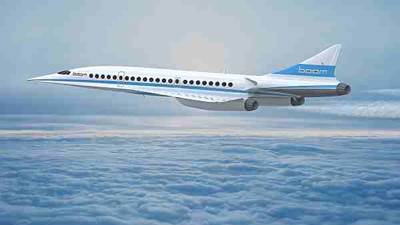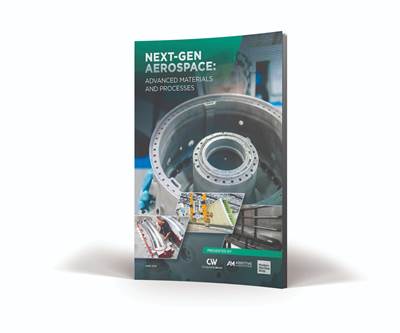Boom Supersonic announces plans for XB-1 demonstrator roll-out
The company says it will complete its XB-1 supersonic aircraft demonstrator by December, with flight tests next year.

Blake Scholl, founder and CEO of Boom Supersonic, spoke about the company’s goals for the XB-1 aircraft at a press conference on June 18. CW photo | Jeff Sloan
Boom Supersonic (Denver, Colo., U.S.) plans to roll out XB-1, its two-seat supersonic demonstrator aircraft, in December 2019, with supersonic flight planned for 2020, the company announced at a press conference held at the Paris Air Show on June 18.
XB-1 is a milestone on the way to Overture, Boom’s supersonic commercial jet. Overture reportedly will offer revolutionary service to passengers and will also be cost-effective and environmentally sustainable compared to traditional aircraft.
XB-1’s unveiling later this year and supersonic flight in 2020 will provide Boom with valuable data and experience to support the development of Overture, the company says, and will likely influence the aerodynamic design and calibration, stability and control, evaluation of handling qualities and development of propulsion inlet, nozzle and control systems.
Scholl also announced a new partnership with Prometheus Fuels (San Mateo, Calif., U.S.), a specialist in the field of sustainable alternative fuels. Prometheus’ technology is said to economically remove CO2 from the air, using clean electricity to transform it into gasoline, diesel and jet fuel.
The electricity used in this process is reportedly generated from alternative sources, such as wind and solar power, meaning there are no net CO2 emissions generated throughout the process. Because the fuel is made from atmospheric CO2, it is carbon neutral when burned, releasing no net carbon into the air. Boom plans to use Prometheus fuel to power XB-1 in the world’s first supersonic flight using carbon-neutral fuel.
“Today, we have the advanced technology to realize faster air travel, and our teams have been working tirelessly over the past few years to build the first civil supersonic plane since Concorde,” said Blake Scholl, founder and CEO of Boom.
Scholl was joined at the event by Takeshi Morita, director of the business creation strategy department at Japan Airlines (JAL; Tokyo, Japan), a strategic partner and investor in Boom. “Our continued strategic partnership with Japan Airlines as well as new partnerships are a testament to our commitment to make supersonic flight a reality. We’re excited to participate in our second Paris Air Show and to be here sharing our progress toward a faster future,” Scholl said.
XB-1 engineering and production milestones achieved during the past 12 months have included:
- XB-1 aerodynamic design validation;
- engine operability testing;
- alternative fuel engine testing;
- supersonic inlet wind tunnel testing;
- full range flight telemetry system testing;
- spin tunnel testing;
- fully comprehensive aero database generation;
- systems verification of safety goals; and
- completion of forward fuselage and wing skin tools.
Boom recently added a second test pilot to its team, Chris “Duff” Guarente, who holds a Master’s of Flight Test Engineering from the USAF Test Pilot School and who recently flew the historic Stratolaunch first flight. Guarente joins Bill “Doc” Shoemaker, who has been providing guidance in the development of XB-1 since joining Boom in 2018.
In 2019, Boom has also announced additional strategic partnerships with Dassault Systèmes (Waltham, Mass., U.S.) on a design platform for Overture, JPA Design (London, U.K.) on aircraft interior for Overture and Stratasys (Eden Prairie, Minn., U.S.) on 3D-printing of polymer-based parts for both XB-1 and Overture.
Related Content
Plant tour: Albany Engineered Composites, Rochester, N.H., U.S.
Efficient, high-quality, well-controlled composites manufacturing at volume is the mantra for this 3D weaving specialist.
Read MoreThe potential for thermoplastic composite nacelles
Collins Aerospace draws on global team, decades of experience to demonstrate large, curved AFP and welded structures for the next generation of aircraft.
Read MorePlant tour: Spirit AeroSystems, Belfast, Northern Ireland, U.K.
Purpose-built facility employs resin transfer infusion (RTI) and assembly technology to manufacture today’s composite A220 wings, and prepares for future new programs and production ramp-ups.
Read MoreA new era for ceramic matrix composites
CMC is expanding, with new fiber production in Europe, faster processes and higher temperature materials enabling applications for industry, hypersonics and New Space.
Read MoreRead Next
Is supersonic flight making a comeback?
Boom Technology (Denver, CO, US), a 2014 start-up aircraft developer, is in the process of building the XB-1, a flying 1/3-scale demonstrator of its supersonic (faster than sound) commercial aircraft.
Read MoreNext-Gen Aerospace Special Edition
Read the Next-Generation Aerospace Special Edition, produced in partnership with CompositesWorld, Modern Machine Shop and Additive Manufacturing.
Read MoreBoom Supersonic, JPA Design to develop interior for Overture airliner
Boom Supersonic’s Overture Mach-2.2 supersonic aircraft will travel twice the speed of regular aircraft.
Read More
.jpg;width=70;height=70;mode=crop)

























